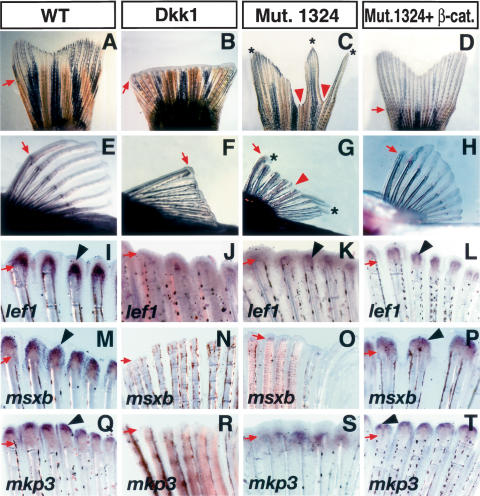Figure 2.
Wnt/β-catenin is necessary and enhances fin regeneration in zebrafish. (A–H) Gross morphology of the caudal fin (A–D) and pectoral fin (E–H) of adult zebrafish 7–10 d after amputation with or without virus injection. The caudal fin (A) and pectoral fin (E) regenerated normally in wild-type zebrafish after amputation. Ad-Dkk1 injection after amputation inhibited regeneration in both the caudal fin (B) and pectoral fin (F), demonstrating the necessity of Wnt/β-catenin signaling for fin regeneration. The #1324 mutant fish caudal fin (C) and pectoral fin (G) showed defective regeneration, and only certain areas of the fin showed regeneration (asterisks). Injection of Ad-CA-β-catenin restored fin regeneration in the #1324 mutant. Both the caudal fin (D) and pectoral fin (H) regenerated similarly to that of wild-type fins. (I–T) In situ hybridization of lef1 (I–L), msxb (M–P), and mkp3 (Q–T) in pectoral fins 2 d after amputation with or without virus injection. In the wild-type fin, lef1 (I), msxb (M), and mkp3 (Q) are strongly expressed. In Ad-Dkk1 injected fins, expression of lef1 (J), msxb (N), and mkp3 (R) is barely detectable. In #1324 mutant fins, expression of lef1 (K), msxb (O), and mkp3 (S) is significantly down-regulated when compared with control fins. Injection of Ad-CA-β-catenin restored expression of lef1 (L), msxb (P), and mkp3 (T) in the #1324 mutant fin. Arrows indicate the amputation level. Red arrowheads and asterisks in C and G indicate defects in regeneration and regenerated tissue in the #1324 mutant. Arrowheads in I–T indicate gene expression.

